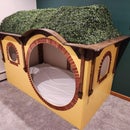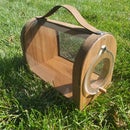Introduction: CNC Catan Board
I had seen various wooden Catan sets before but I really wanted to create my own. This is the main reason I decided to build a cnc router. Many versions were just laser engraved and were just made out of one kind of wood that was painted/stained different colors depending on the resources. I wanted to make each resource tile out of a different wood, using it's natural color to represent the materials.
Supplies
CNC Supplies:
CNC Router (I used my MPCNC)
Wood:
- Sheep: Maple
- Wood: Poplar
- Wheat: Oak
- Brick: Padauk
- Ore: Wenge
- Desert: Walnut
- Wood sealant
Bits:
- 1/16 two flute end mill
- 1/8 two flute end mill
- 30 degree v-bit
3D Printing Supplies:
3D Printer (I used my Prusa MK3S)
Filament:
- SpiderMaker Matte PLA+ (Emerald Green, Cheese Yellow, Steel Blue, Coral Red)
- Marble PLA
Step 1: Collecting Designs
I considered designing all my own printed pieces but decided to check out what others had designed first to see if I could save some time. I needed these before I designed my tiles so I could design the tiles to accommodate their shapes.
I ended up really liking the following .stl files on Thingiverse so I decided to use them for the 3D printed pieces:
I went through the wood I had and what the local stores had to figure out what wood would best represent each type of resource. I decided on the following:
Sheep: Maple
Wood: Poplar
Wheat: Oak
Brick: Padauk
Ore: Wenge
Desert: Walnut
Step 2: Designing the Hex Tile
I designed the tiles to be the same size as the standard Catan tiles but I added indents for the cities/settlements in the corners and indents for the roads along the flats so that they would stay in place if the table is bumped. I made sure to make them a tad bigger than the piece models. I then saved the drawing as a .dxf file that way the dimensions would remain.
All .dxf files can be found HERE. They are all in mm if you wish to keep the same scale as the standard game.
Step 3: Designing the Border Tiles
I added all the hex tiles together and used them to create the border pieces. I wanted the border to be round instead of hex shape but still needed there to be six pieces so that three could have 2 ports and three could have 1 port. I added puzzle piece like ends to them so they would link together. I also added the same indents to match the hex pieces. They were designed the same until I added the ports. I added two ports to one of them and one I added one port to the other. I would need to cut out three of each kind.
The square corners of the port point to the two locations that the port applies to.
Step 4: Designing the Number and Trading Tiles
The number tiles and trading tiles were created to be the same shape as the pockets I had already created in the previous parts. I should have made the port pieces a tad smaller like I did with the number tiles. I ended up having to lightly sand them to get them to fit.
Step 5: Assembly Check
Once I created all the individual parts, I needed to put it all together in an assembly just to double check I didn't goof up anything when designing it. Everything fit up well and I didn't see any concerns.
Step 6: Symbol Designs
I wanted a minimalistic design to mine and instead of doing one large image over the entire surface I wanted to use 3 smaller symbols per hex tile. I looked around on the internet and found These Designs. I got the designers permission to make modified versions to accommodate my engraving. I used Solidworks to sketch these and then saved them as .dxf files so that I could just engrave along the lines.
Step 7: CNC Router Setup
I needed to make sure this was as consistent as I could so I set up a 2 inch wide piece along the edge that I would use to make sure the height was the same on every piece. My cnc router auto homes in that corner and then I used a z-probe on that stationary piece to make sure the height was the same every time. I just had to accommodate for this piece in when I set up the GCode in the cam software.
Step 8: Setting Up the Cam Program to Generate the CNC GCode
I added the tile pieces I need into my cam software (I used ESTLCAM because it is simple and cheap and works well for my needs) and then aligned them onto the board size I had. I then added the symbols and text that I needed and made sure they were aligned as I wanted them on the piece.
I didn't walk through every step in setting this up because you may be using a different cam software but it should be noted that you can see my cutting settings and the colors in the pictures indicate different cutting depths. The entire piece is a green-ish color because that was the surfacing pass to make them the same height. You can also see the 2 inch space I put on the left to account for the wood piece that sets the height.
If you are wondering what the random symbol is in the empty space, I cut a sample symbol on each piece to test how well the symbol would come out before I continued with the cut. It helped out a couple times when I found out I needed to modify the shape to machine better.
I had to use the 1/16 bit for the road indents due to the smaller size. I used the 1/8 bit for the city/settlement indent along with surfacing the top to ensure all the tiles are the same height.
I then used the v-bit to engrave the symbols and text. I finished it off by using the 1/8 but to cut out the pieces.
This involved multiple tool changes so you will need to make sure you are comfortable with that. I did quite a few other projects that I cared less about to make sure I had the tool changing down.
Step 9: Cutting Out the Pieces
Here you can see the pieces after I ran the GCode. I don't have a good way to record the cutting at the moment so I only have the pictures of after the cut. I only remembered to take pictures of some of them but they all look pretty much the same after the cutting. As you can see, the pieces are shorter than the wood it was cut from. This is ensuring all the pieces are the same height since there is some variation on wood thicknesses.
I cut this on my MPCNC. It is a great cnc router for any hobbyist because it can be made to the size you need (to an extent) and is very affordable. If you want to know more check out the site HERE.
I just added a picture of the sawdust because it looks cool to see the different layers from the different wood types.
Step 10: Sheep Tiles
Here are closeups of the sheep tiles. These were cut out of a 13 x 6 piece of Maple. I decided to cut the 3:1 ports out of maple too because it cuts really well and is the lightest of the woods which allows the engraving to show up better.
Step 11: Brick Tiles
Here are closeups of the brick tiles. These were cut out of a 12 x 6 piece of Padauk. I cut out 4 hex tiles but I only need 3 for the set.
Step 12: Ore Tiles
Here are closeups of the ore tiles. These were cut out of a 12 x 6 piece of Wenge. I also cut out 4 hex tiles but I only need 3 for the set.
Step 13: Wood Tiles
Here are closeups of the wood tiles. These were cut out of a 11 x 8 piece of Poplar. Poplar is not fun to machine because it tends to leave fuzzy edges. I needed to make sure to use a new v-bit for the engraving on this to give me the cleanest edges.
Step 14: Wheat Tiles
Here are closeups of the wheat tiles. These were cut out of a 9 x 8 piece of Oak.
Step 15: Desert Tile
Here are closeups of the desert tile. This was cut out of a 6 x 3 piece of Walnut. I made sure to only cut the center hole 2mm deep so that the robber would have an indent to sit into.
Step 16: Number Tiles
Here are closeups of the number tiles. These were cut out of a 6 x 6 piece of Maple. Normally Catan has the 6 and 8 tiles different to make them stand out but since we are very familiar with the game I made them all the same. If you want them to stand out then you can paint the 6 and 8 tiles red like the game does. There should be two of every number 1-12 except that there are no 1 or 7 pieces and only one 2 and one 12 piece.
Step 17: Border Tiles
Here are closeups of the border tiles. These are made out of 6 11 x 6 pieces of Maple. There needs to be 3 of each kind.
Step 18: 3D Print the Pieces
I really liked this filament because of its matte finish and not overly bright colors. Unfortunately it is out of stock often and is a bit pricy but it prints super nice. I also wanted a granite style filament to go along with it because I though the colors looked good together.
I printed these with a 0.2mm nozzle to get the best resolution for the intricate details.
For a standard set, you need 4 cities, 5 settlements, and 15 roads or each color. You also need a single robber.
Step 19: (Optional) 3D Print Expansion Pieces
My wife and I really like the cities and knights expansion so I also printed the pieces needed for that. It requires 6 knights (2 level one, 2 level two, and 2 level three) with their activation crowns and three city walls for each color. It also needs three metropolises that I printed out of the granite.
Step 20: Assemble and Play
Now with everything cut it just took some light sanding to remove any burs and then I applied a light coat of sealant just in case anything spills on it. Then it's time to play.
Just in case anyone wanted to know the size there is a banana for scale.
I really like the set and it is lots of fun to play with. I hope you enjoyed and maybe inspired you to make one yourself.

Runner Up in the
1000th Contest













